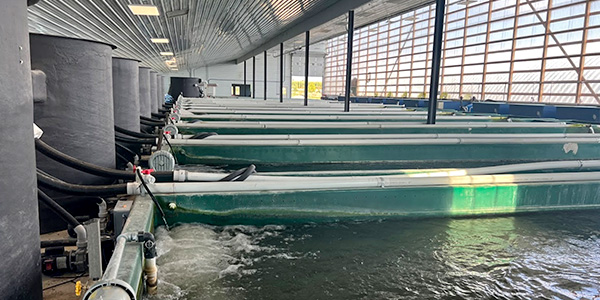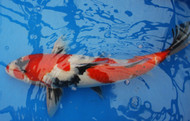Why Are Some Koi Fish So Expensive?
Posted by Kloubec Koi Farm on 17th Feb 2025
Koi fish can fetch eye-watering prices due to a perfect storm of factors. Prized specimens boast impeccable genetic lineages, honed through decades of meticulous breeding. Their vibrant hues and intricate patterns are a feast for the eyes, with only a tiny fraction achieving show-quality status. Size matters too—jumbo koi over 24 inches are the crème de la crème. Age plays a role, with mature females maintaining high value for breeding potential. The koi market is a numbers game: out of millions bred annually, perhaps 50 make the cut as top-tier fish. This scarcity, coupled with intense demand, sends prices skyrocketing. Dive deeper, and you'll uncover even more fascinating aspects of these living jewels.
Genetic Lineage and Breeding
The genetic lineage of koi fish plays a pivotal role in determining their market value. Breeders invest years, even decades, in perfecting bloodlines that consistently produce stunning specimens.
It's a numbers game, really - millions of koi are bred annually, but only a select few make the cut for show quality. We're talking about 50 fish, tops. That's some serious exclusivity!
Kloubec Koi Farm, a premier North American breeder, specializes in producing high-grade show fish comparable to imported varieties, leveraging their extensive breeding expertise and Japanese parent stock.
These prized koi aren't just pretty faces; they're living works of art, sculpted by generations of selective breeding.
The secret sauce? It's all in the genes. Those vibrant hues and intricate patterns that make you go "wow" are the result of painstaking genetic manipulation. Breeders focus on enhancing specific traits, like the depth and distribution of color cells in the skin. It's like painting with DNA!
The payoff for this genetic wizardry can be astronomical. We're not talking chump change here - top-tier koi can fetch prices that'll make your eyes water.
Hundreds of thousands, even millions of dollars for a single fish! It's a high-stakes game where bloodlines are worth their weight in gold.
Coloration and Pattern Rarity
While genetic lineage forms the foundation of a koi's value, coloration and pattern rarity are the visual manifestations that captivate collectors and drive prices skyward. The most coveted koi showcase vibrant hues like deep reds, bright yellows, and eye-catching metallic shades that span at least three scales.
It's not just about the colors, though - uniformity is key. A flawless koi should maintain its stunning appearance even when in motion, without any pesky white blemishes peeking through.
Every koi variety has a centuries-old, predetermined, set of standards which must be obeyed. For each individual koi, the closer its pattern comes to the ideal of perfection for the variety, the higher the price soars.
Talk about needle in a haystack! Only a tiny fraction of koi born each year meet the stringent standards for show quality, making these living works of art incredibly rare and valuable.
Selective breeding has turned koi cultivation into a fine art, with breeders laser-focused on enhancing color depth and pattern clarity. The result? Koi that aren't just pretty fish, but jaw-dropping investments that can make your wallet weep and your pond sparkle.
Size and Body Shape
When it comes to koi fish, does size really matter? Maybe, it all depends on the koi owner’s desire and preference. In the world of koi connoisseurs, bigger often means better—and pricier. Jumbo koi, those impressive specimens stretching beyond 24 inches, are the rock stars of the pond world. These aquatic giants command top dollar, not just for their sheer size but for the wow factor they bring to any koi collection.
Take "Big Girl," for instance, a whopping 90-pound behemoth measuring 48 inches long. She's not just a fish; she's a living legend that exemplifies why size is such a big deal in koi circles. But it's not all about length and weight. A koi's body shape is equally essential, with judges and collectors alike swooning over fish with smooth lines and strong builds.
| Size Category | Length | Desirability | Price Range |
| Standard | < 24" | Moderate | $$ |
| Jumbo | 24" - 36" | High | $$ |
| Super Jumbo | 36" - 40" | Very High | $$$ |
| Record-Breaker | > 40" | Extreme | $$$+ |
Age and Growth Potential
Consider these intriguing aspects of koi aging and growth:
- The sweet spot: Koi between 5-12 years old often fetch top dollar, as they've reached impressive sizes while still harboring untapped potential.
- The centenarian club: Some koi live to see their 200th birthday, becoming living legends in the process.
- The growth spurt: Young koi with excellent genetics can experience rapid growth, skyrocketing their value in a short time.
Interestingly, older koi might see their market value dip as their growth potential wanes.
But don't count out the senior citizens of the koi world just yet! Mature females can still command hefty prices due to their breeding potential.
It's a delicate balance of age, size, and future promise that keeps koi enthusiasts on their toes and wallets at the ready.
Market Demand and Scarcity
The koi market's dynamics are heavily influenced by the scarcity of exceptional specimens and the intense demand from collectors and enthusiasts. Obtaining a Koi health certification can also impact pricing. Buying from reputable breeders is recommended as the best practice.
It's a numbers game, really - only about 50 out of 50,000 annual koi births are considered show quality. That's like finding a needle in a haystack, except the needle is a living, swimming work of art.
This rarity factor sends prices soaring into the stratosphere. We're talking tens of thousands of dollars for a single fish.
But it's not just about looks; it's a whole package deal. Japanese imports, in particular, are thought by some, to be the cream of the crop, commanding top dollar for their superior genetics and drop-dead gorgeous appearances.
The koi world is also subject to seasonal whims and trends. Collectors scramble to snag specific varieties, creating a frenzy that would make Black Friday shoppers blush.
And let's not forget the rock stars of the koi world - those bred by award-winning breeders. Their offspring are like the fish equivalent of designer handbags, with price tags to match.
It's a wild, colorful market where beauty truly is in the eye (and wallet) of the beholder.
Conclusion
The world of koi fish is a fascinating blend of art, science, and passion. While some koi can be purchased for pocket change, others command prices rivaling luxury cars. This stark contrast reflects the intricate factors that contribute to a koi's value: impeccable genetics, rare coloration, impressive size, and market scarcity. Ultimately, the most expensive koi represent the pinnacle of breeding expertise, collector enthusiasm, and the timeless allure of living art, transforming humble pond dwellers into aquatic treasures, hence the reference to the term “Living Jewels”.


